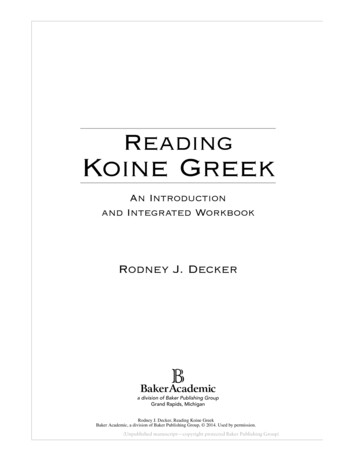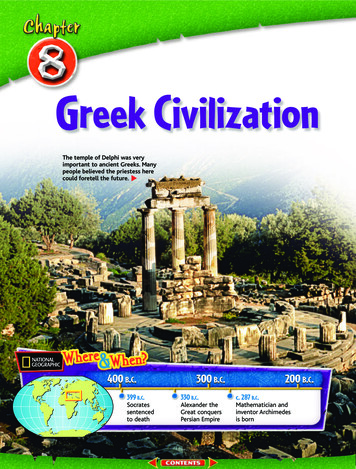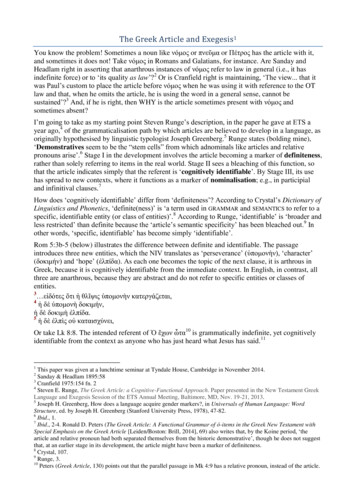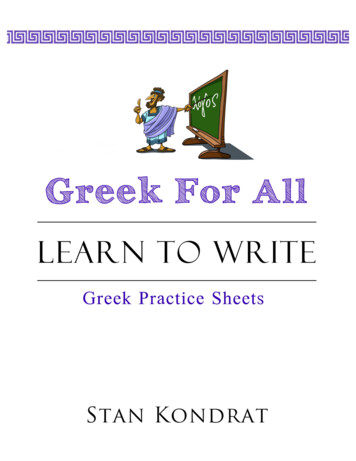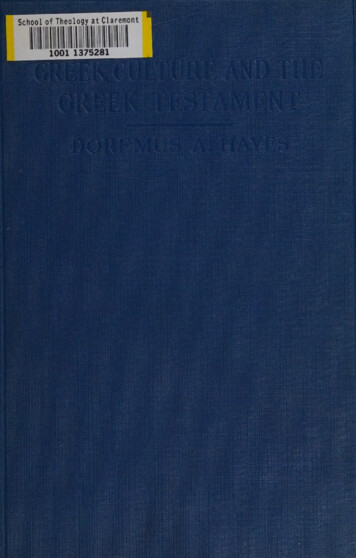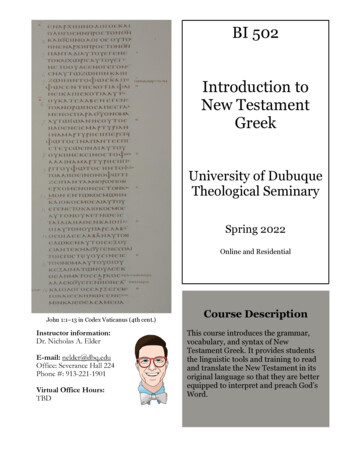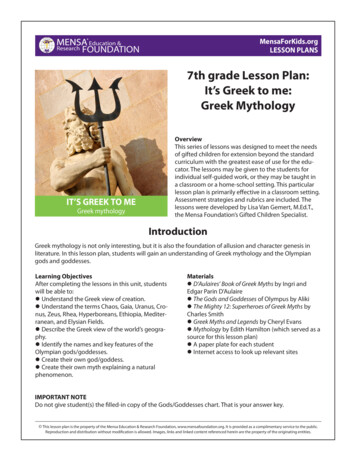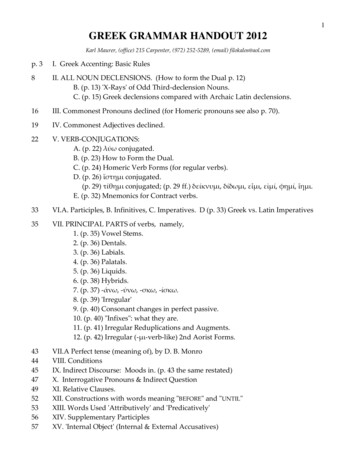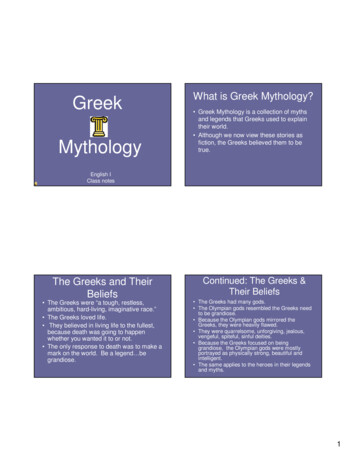
Transcription
Greek Manual:Language and Culture
2Prepared by:Meredith Dawson, B.S.Kendall Fritsch, B.S.Texas State University class of 2012Academic AdvisorRahul Chakraborty
3Table of ContentsGreek Demographics & Language .Geographical Distribution of the Greek Language .Linguistic Community .Greek Population in America .Demographic Information of Greece Geography Religion .Education .Languages Spoken in Greece .Linguistic Features Consonants .Vowels .Syllables .Consonants & Consonant Clusters .Tones .Stress & Intonation Phonology .Morphology & Syntax .Vocabulary/Semantics .Writing System .The Greek Alphabet .Greek Language Acquisition .Greek/English Bilinguals .Common Errors Pronunciation Differences Speech Language Pathology & the Greek Language .Assessments . Intervention . .SLPs With a Greek Background .Social Aspects of Greece .Culture & Society Family . .Traditions & Customs . .Superstitions .Food . .Music . Resources . .Web Resources Research Articles References 202022232427272730
4Greek Demographics & LanguageGreek, called “el-li-ni-ka” by Greek speakers, is an independent branch of the Indo-Europeanfamily of languages. Native to the southern Balkans, it has the longest documented history ofany Indo-European language, spanning 34 centuries of written records. Its writing system hasbeen the Greek alphabet for the majority of its history. The alphabet arose from the Phoenicianscript, and was in turn the basis of the Latin, Cyrillic, Coptic, and many other writing systems.The Greek language holds an important place in the histories of Europe, the more looselydefined “Western” world, and Christianity. Greek roots are often used to coin new words forother languages, especially in the sciences and medicine. Greek and Latin are the predominantsources of the international scientific vocabulary. More than 150,000 words of the Englishlanguage are of Greek origin. Greek is the official language of Greece, where it is spoken byalmost the entire population. It is also one of the official languages of Cyprus and is recognizedas a minority language in Albania, Armenia, Italy, Romania, Turkey, and Ukraine.The above information is from: http://en.wikipedia.org/wiki/Greek language eek.htmlGeographical Distribution of the Greek LanguageCurrently there are approximately 13 million Greek speakers, with about 10 million in Greeceand 500,000 in Cyprus. The remainder Greek speakers are in the modern Hellenic diaspora,which is also known as the Greek diaspora. The Hellenic diaspora refers to the communities ofGreek people living outside the traditional Greek homelands, but more commonly in southeastEurope and Asia Minor. Members of the diaspora can be identified as those who themselves, orwhose ancestors, migrated from the Greek homelands.The above information is from: (Joseph, 2001) & http://en.wikipedia.org/wiki/Greek diasporaThere are traditional Greek-speaking settlements in the neighboring countries of Albania, theRepublic of Macedonia, Bulgaria and Turkey, as well as in several countries in the Black Sea areasuch as Ukraine, Russia, Romania, Georgia, Armenia and Azerbaijan, the Republic of Macedonia,and around the Mediterranean Sea, Southern Italy, Israel, Egypt, Lebanon and ancient coastaltowns along the Levant. The language is also spoken by Greek emigrant communities in manycountries in Western Europe, especially the United Kingdom and Germany, in Canada and theUnited States, Australia, as well as in Argentina, Brazil, Chile and others.The above information is from: http://en.wikipedia.org/wiki/Greek language
5This map of the top 50 countries with the largest Greek communities is from:http://en.wikipedia.org/wiki/File:50 largest Greek diaspora.pngLinguistic CommunityLike many other languages, Greek is divided into a number of dialects. The main moderndialects are: Peloponnesian-Ionian, Northern, Cretan, Old Athenian, and Southeastern(including the islands of Dodecanese and Cypriot Greek). The major features distinguishingthese dialects include deletion of original high vowels and raising of the original mid-vowelswhen unstressed in the Northern varieties, loss of final –n in all but the Southern varieties,palatalization of velars in all but the Peloponnesian-Ionian, use of accusative for indirect objectsin the Northern dialects instead of the genitive, among others. Peloponnesian-Ionian forms ofthe historical basis for what has emerged in the 20th century as Standard Modern Greek, and isthus the basis for the modern Athens, now the main center of population.The above information is from: (Joseph,2001). The map of the dialects is from:http://en.wikipedia.org/wiki/Varieties of Modern Greek
6Greek Population in AmericaThe United States is home to the largest overseas Greek community, ahead of Cyprus and theUnited Kingdom. There are a total of approximately 1,350,600-3,000,000 people of Greekancestry living in the United States, which is 0.4%-1% of the total U.S. population. Regions withsignificant populations are New York City, Chicago, Detroit, Boston, Baltimore, and Cleveland.Tarpon Springs, Florida is also home to a large Greek American community and the highestconcentration of Greek-Americans in the country (11%). The 2000 census revealed that Greekwas spoken at home by 365,436 people older than five.The above information & map of thedistribution of Greek Americans emographic Information of GreecePopulation: 10,760,136Median age: 42.5 yearsPopulation growth rate: 0.083%Birth rate: 9.21 births/1,000 populationDeath rate: 10.7 deaths/1,000 populationSex ratio: 0.96 male(s)/femaleLife expectancy at birth: 79.92 yearsNationality: GreekEthnic groups: Greek 93%, other (foreigncitizens) 7%Religions: Greek Orthodox (official) 98%,Muslim 1.3%, other 0.7%Languages: Greek (official) 99%Literacy (definition: age 15 and over can read and write): total population: 96%The above information and map of Greece is from:http://www.indexmundi.com/greece/demographics profile.html &http://www.greekshares.com/dimographics.php, respectively
7Map of Greece is from: graphy of GreeceGreece consists of a mountainous, peninsular mainland jutting out into the sea at the southernend of the Balkans, ending at the Peloponnese peninsula (separated from the mainland by thecanal of the Isthmus of Corinth). Due to its highly indented coastline and numerous islands,Greece has the twelfth longest coastline in the world with 8,498 mi.Greece features a vast number of islands, between 1200 and 6000, depending on the definition,227 of which are inhabited. Crete is the largest and most populous island. Eighty percent ofGreece consists of mountains or hills, making the country one of the most mountainous inEurope. Mount Olympus, the mythical abode of the Greek Gods, culminates at Mytikas peak2,917 m (9,570 ft), the highest in the country. Western Greece contains a number of lakes andwetlands and is dominated by the Pindus mountain range.Greece primarily has a Mediterranean climate, featuring mild, wet winters and hot, drysummers. The mountainous areas of Northwestern Greece feature an Alpine climate withheavy snowfalls. The inland parts of northern Greece feature a temperate climate with cold,damp winters and hot, dry summers with frequent thunderstorms. Snowfalls occur every yearin the mountains and northern areas, and brief snowfalls are not unknown even in low-lyingsouthern areas, such as Athens.The above information is from: http://en.wikipedia.org/wiki/GreeceReligion in GreeceAccording to the Greek constitution, Eastern Orthodox Christianity is recognized as the“prevailing religion” in Greece. The Church is often credited with the preservation of the Greeklanguage, values, and national identity during Ottoman times. The Church was also animportant rallying point in the war for independence. The Church of Greece was established
8shortly after the formation of a Greek national state. There is a Muslim minority concentratedin Thrace and officially protected by the Treaty of Lausanne. There are also a number of Jews inGreece, most of who live in Thessaloniki. There are also some Greeks who adhere to areconstruction of the ancient Greek religion.The above information is from: http://en.wikipedia.org/wiki/GreeceEducation in GreeceGreek education is free and compulsory for children between the ages of 5 and 15. Englishstudy is compulsory from third grade through high school. University education, includingbooks, is also free, contingent upon the student’s ability to meet stiff entrance requirements. Ahigh percentage of the student population seeks higher education. More than 100,000 studentsare registered at Greek universities, and 15% of the population currently holds a universitydegree. Admission in a university is determined by state-administered exams, the candidate’sgrade-point average from high school, and his/her priority choices of major. About one in fourcandidates gains admission to Greek universities.The above information is from: http://en.wikipedia.org/wiki/GreeceLanguages Spoken in Greece98% of the 10.6m population of Greece speaks Greek, which, as mentioned above, is thecountry's official language. The largest minority language is Macedonian, spoken by 1.8% of thepopulation. Others include Albanian, spoken in the centre and the south, Turkish, spoken byMuslim communities around the Aegean, and Arumanian and Bulgarian. None of these minoritylanguages has official status.The above information is from: iquette/greece-country-profile.html
9Linguistic FeaturesConsonantsGreek has 31 consonants including allophones and affricates and is most closely related toAncient Greek. The voiceless plosives /p, t, k/ are unaspirated, the voiced plosives [b, d, g] arefully prevoiced and sometimes prenasalized in formal speech depending on personal speakingstyle and dialect. The use of prenasalization appears to be in decline; however, as it was foundthat younger Athenian speakers produce them only rarely.Table: Consonants produced in GreekVowelsGreek has five vowels /I, ε, å, o, u/. Unstressed /i/ and /u/ may be devoiced or elided in casualspeech. Furthermore, vowel sequences can sometimes be pronounced as a short diphthong.Table: Vowels produced in GreekSyllablesThe syllable structure of Greek can be described in the formula C(0-3)VC(0-1). Greek,however, has a tendency to have open syllables, and most words tend to be bi-syllabic or multisyllabic.The information on this page is from: (Mennen, & Okalidou, 2006)
10Consonants & Consonant ClustersAny consonant can occur in syllable-initial position. Consonants in syllable-final word-finalposition are restricted to /s/ and /n/, except in loan-words and remnant words fromKatharevousa where other final consonants (or clusters) can occur. As a result, many Greekwords end in a vowel.It is recognizes as many as 65 clusters in syllable-initial and word-initial position. Clusters canappear in word-initial and word-medial position, but are not allowed in word-final position(except in borrowings from Katharevousa and some loanwords).Homorganic sequences are notpermissible in Greek, and there is a tendency to convert a sequence of two voiceless fricativesor stops into a fricative plus stop sequence. In /s/-clusters, the /s/ assimilates to the followingconsonant and becomes voiced before a voiced consonant. There are also many hetero-syllabicclusters in Greek which can consist of up to four consonant phonemes.TonesGreek does not use tones to differentiate meaning.Stress & IntonationGreek is a syllable-timed language and its rhythmic characteristics are very similar to thosereported for Italian. Main stress falls on one of the last three syllables of a word, and stressplacement is mostly determined by morphology. Secondary stress only occurs when words withstress on the antepenult (or penult) are followed by one (or two) enclitic(s) and the additionalstress is placed on the penultimate syllable of the word enclitic group. An enclitic is anunstressed word that is incapable of standing on its own and is phonologically joined at the endof a preceding word to form a single unit. There are several minimal pairs where stress is theonly difference between words.Greek has 5 pitch accents:L* H: Rise from low from the accented syllable to high after the accented syllable;frequently used in nuclear position in calls, imperatives, negative declaratives and whquestionsL H*: Rise from low to the accented syllable, which is high; often used to signal narrowfocusH*: High level from the accented syllable; often used as the nucleus in broad focusdeclarativesH* L: A fall from high pitch in the accented syllable, indicating a more nonchalantattitude on the part of the speaker than H*L*: Low level from the accented syllable; it appears as the nuclear accent before acontinuation rise, in yes-no questions, and in suspicious callsThe most common of these is the L* H pitch accent. The pitch accents can be combined withthree types of phrase accents and three types of boundary tones to form intonation contours.The information on this page is from: (Mennen, & Okalidou, 2006)
11PhonologyModern Greek has five distinct vowel sounds (/i/, /e/, /a/, /o/, /u/) and the glide /y/, most ofwhich are indicated in Greek orthography in more than one way. The consonant sounds are:Historically, /f, th, kh/ derive from ancient aspirated consonants, and the voiced fricatives /v,dh, gh/ from voiced stops /b, d, g/. Modern /b, d, g/ usually result from the voicing of /p, t, k/after nasals; thus Ancient Greek pente ‘five’ becomes pénde. They also occur at the beginningof words in place of ancient nasal stop sequences (boró ‘I am able’ from emporó). Otherimportant consonant cluster changes linking Ancient and Modern Greek include:Ancient clusters, whether of stops or of aspirates, become fricative stop; for example,hepta ‘seven’ becomes eftá, (e)khthes ‘yesterday’ becomes (e)khtésDouble consonants are simplified except in the southeast, thus thalassa ‘sea’ becomesthálasaNasals assimilate to the following fricatives; thus nymphē ‘bride’ becomes níffi and then(except in the southeast dialects) nífiThe liquid /l/ may be replaced with /r/ before consonants; for example, adelphos‘brother’ becomes adherfósBefore a vowel, /i/ and /e/ change to /y/; thus paidia ‘boys’ becomes pedhyá, mēlea‘apple tree’ becomes milyá. Except for the simplification of double consonants, thesehistorical changes do not hold for words of Katharevusa originWith the changes produced in the vocalic system in Koine, the ancient pitch distinction was lostand stress became dynamic (as in English), its place being indicated orthographically by auniform stress mark; but it remained confined to the three last syllables of a word (thetrisyllabic, or window, constraint). Stress placement is largely predictable, depending fornominals on their declensional class marker (e.g., ánthropos ‘man’ versus polítis ‘citizen’ *-oversus –I class]), but for the verb on their tense (e.g., katháriz-a ‘I cleaned’ versus katharíz-o ‘Iclean’ *past versus nonpast tense]).Further stress shift may occur owing to the trisyllabic constraint, as in máthima givesmathímata ‘lesson’ (nominative singular or plural), or as a morphological relic of an earlier longō-vowel in the genitive plural—e.g., mathímata becomes mathimáton ‘lesson’ (nominative orgenitive plural). The addition of clitics (words that are treated in pronunciation as forming apart of a neighbouring word and that are often unaccented or contracted) may provoke furtherstressing in the host clitic unit if the trisyllabic constraint is violated, as in máthima: butmáthima-mu becomes máthimá mu ‘lesson’ becomes ‘my lesson.’ In some dialects, especially inthe north, the tendency to a rhizotonic (stable) stressing extends to the verb, leading either to
12violations of the trisyllabic constraint or to an additional stress (as in the case of clitics)—e.g.,tarázumasti or tarázumásti ‘we are shaken’ (standard tarazómaste).The phonology information is 595/Greek-languageMorphology & SyntaxMuch of the inflectional apparatus of the ancient language is retained in Modern Greek. Nounsmay be singular or plural—the dual is lost—and all dialects distinguish a nominative (subject)case and accusative (object) case. A noun modifying a second noun is expressed by the genitivecase except in the north, where a prepositional phrase is usually preferred. The indirect objectis also expressed by the genitive case (or by the preposition se ‘to,’ which governs theaccusative, as do all prepositions). Thus:The ancient categorization of nouns into masculine, feminine, and neuter survives intact, andadjectives agree in gender, number, and case with their nouns, as do the articles (o ‘the,’ enas‘a’). In general, pronouns exhibit the same categories as nouns, but the relative pronoun pu isinvariant, its relation to its own clause being expressed when necessary by a personal pronounin the appropriate case: I yinéka pu tin ídhe to korítsi ‘the woman pu her saw the girl’ (i.e., ‘thewoman whom the girl saw’).The verb is inflected for mood (indicative, subjunctive, imperative), aspect (perfective,imperfective), voice (active, passive), tense (present, past), and person (first, second, and third,singular and plural). The future is expressed by a particle tha (from earlier thé*o na ‘*I wantto’) followed by a finite verb—e.g., tha grápho ‘I will write.’ Formally, the finite forms of theverb (those with personal endings) consist of a stem (optionally) the perfective aspect marker(-s- in active, -th- in passive) personal ending (indicating person, tense, mood, voice). Pastforms are prefixed by e- (the “augment”), usually lost in mainland dialects when unstressed.There are also two nonfinite forms, an indeclinable present active participle in –ondas(ghráfondas ‘writing’), and a past passive one in –ménos (kurazménos ‘tired’).Aspectual differences play a crucial role. Roughly, the perfective marker indicates completed,momentary action; its absence signifies an action viewed as incomplete, continuous, orrepeated. Thus the imperfective imperative ghráphe might mean ‘start writing!’ or ‘writeregularly!’ while ghrápse means rather ‘write down! (on a particular occasion).’ Compare alsotha ghrápho ‘I’ll be writing’ but tha ghrápso ‘I’ll write (once).’ The difference is sometimesrepresented lexically in English: ákuye ‘he listened’ and ákuse ‘he heard.’ The passive forms arelargely confined to certain verbs active in meaning like érkhome ‘I come,’ fováme ‘I am afraid,’and reciprocal usages (filyóndusan ‘they were kissing’).
13The most common form of derivation is by suffixation; derivation by prefixation is limitedmainly to verbs. Compound formation is rich. Three morphological types of compounds can bedistinguished, as reflected also in their stressing—thus, stem stem compounds—e.g.,palyófilos ‘old friend’ (o is the compound vowel) or khortofághos ‘vegetarian’; stem wordcompounds—e.g., palyofílos ‘lousy friend’ (compare fílos ‘friend’); and the newly borrowedformation, word word compounds—e.g., pedhí thávma as English ‘boy wonder.’ There is noinfinitive; ancient constructions involving it are usually replaced by na (from ancient hína ‘sothat’) subjunctive. Thus thélo na ghrápso ‘I want to write,’ borí na ghrápsi ‘he can write.’Subordinate statement is introduced by óti or pos (léi óti févghi ‘he says that he is leaving’).Unlike English, Greek (because of its inflectional system) shows flexible word order even in thesimplest sentences. As in Italian, the subject of a sentence may be omitted.The Morphology & Syntax information is 595/Greek-languageVocabulary/SemanticsThe vast majority of Demotic words are inherited from Ancient Greek, although quite oftenwith changed meaning—e.g., filó ‘I kiss’ (originally ‘love’), trógho ‘I eat’ (from ‘nibble’), kóri‘daughter’ (from ‘girl’). Many others represent unattested combinations of ancient roots andaffixes; others enter Demotic via Katharevusa: musío ‘museum,’ stikhío ‘element’ (but inheritedstikhyó ‘ghost’), ekteló ‘I execute.’ In addition, there are more than 2,000 words in common usedrawn from Italian and Turkish (accounting for about a third each), and from Latin, French, and,increasingly, English. The Latin, Italian, and Turkish elements (mostly nouns) acquire Greekinflections (from Italian síghuros ‘sure,’ servitóros ‘servant,’ from Turkish zóri ‘force,’ khasápis‘butcher’), while more recent loans from French and English remain unintegrated (spor ‘sport,’bar ‘bar,’ asansér ‘elevator,’ futból ‘football,’ kompyúter ‘computer,’ ténis ‘tennis’).The Vocabulary/Semantics information is 595/Greek-languageWriting SystemGreek is written in the Greek alphabet, which developed in classical times (ca. 9th century B.C.).The Greek alphabet has 24 letters as well as an accent mark to indicate stressed vowels in bisyllabic or multi-syllabic words and to disambiguate meaning among homorganic monosyllabicwords. Greek spelling is fairly transparent, as in Greek orthography most letters consistentlyrepresent the same sound. However, the same sound can be represented by different letters orpairs of letters. For example, there are 5 different spellings for the sound [i], 2 differentspellings for the sound [o], and 2 different spellings for the sound [s]. This should make spellingmore difficult than reading.The Writing System information is from: (Mennen, & Okalidou, 2006)
14The Greek AlphabetThis table of the Greek alphabet is from:http://www.vtbeta.org/?page greekterms
15Greek Language AcquisitionThe following table demonstrates the age of acquisition for Greek consonants:The table is from: (Mennen, & Okalidou, 2006)
16Greek/English BilingualsCommon ErrorsOne of the most obvious problems native Greek speakers face when trying to speak English ispronunciation. The Greek language contains a few sounds that English doesn’t possess, and viceversa. Greek speakers have trouble with the “ch” and “djuh” sounds, and, especially, with theshort ‘I’ (as in ‘thin’). This is because their language is lacking in these sounds, and so it is veryhard for Greeks to say them correctly. Furthermore, English voiceless stops (p, t, k) are oftenunaspirated in Greek and vowels and diphthongs are often simplified, or shortened.Another common area for errors in speaking English is the use of articles. In Greek, a directarticle usually goes with the noun, but indirect articles are often skipped. Thus, getting a Greekspeaker to understand the precise usage of articles in English can be difficult. A typical mistakeof the Greek speaker might be, “I live in the Greece.” Articular modification of proper nouns isnot used in English, but is in Greek. The lack of an indirect article in Greek comes upoccasionally in situations where the Greek speaker means to say ‘a’ but instead says ‘one’, oromits the article entirely. For example, “I have computer at home.” Another error that may bepresent is in the use of the continuous tense (i.e. progressive –ing). In Greek, the continuous isan entire conjugation of its own, and has distinct forms in the past, present and future. It isused to indicate something you are doing continuously, that is, on an every-day basis, orrepeatedly for a certain time. In an attempt to carry this over into English, the Greek speakermay say, “every Tuesday I am going for swimming.” Conversely, the speaker may use the simpletense when he/she means to use the progressive –ing. For example, “I go to the store” (insteadof “I am going to the store”). Furthermore, Greeks often say ‘of’ when they mean to say ‘from.’This is because both words are covered by the genitive case in Greek and the single prepositionapo.In Greek writing, the placement of commas often differs from in English. Greek language usersmay transpose their own phrasings to English. This most commonly occurs when a Greek writerplaces a comma immediately after the subject. For example, “the cat, likes to drink milk.” This ismost often caused by the individual’s desire to highlight the subject of the sentence, as acomma in Greek writing would do. This tendency can cause problems in the world of definingand non-defining relative clauses, where so much depends on the correct usage of the comma.Other errors that have been noted in Greeks speaking English include: final obstruent devoicing,r to trill, vowel raising, interdental fricative to stop, and vowel fronting.The above information is from: tml &http://accent.gmu.edu/browse language.php?function find&language greek
17Pronunciation DifferencesThe following table provides examples of how Greek speakers may say English words:Pronunciation Errorp bae arar aa oir erI it d“djuh” z“ch” tsExample“bit” instead of “pit”“cart” instead of “cat”“pot” instead of “part”“not” instead of “note”“bear” instead of “beer”“seat” instead of “sit”“die” instead of “tie”“bays” instead of “beige”“wits” instead of “which”The above information is from: http://www.btinternet.com/ ted.power/l1greek.html
18Speech Language Pathology & The Greek LanguageAssessmentsTo date the only available test for speech assessment is the Assessment of Phonetic andPhonological Development, which is an adaptation of Grunwell’s Phonological Assessment ofChild Speech (PACS). However, SLTs in Greece also use informal/homemade single word testsand conversational speech sampling during assessment. No studies have so far documentedprofessional practices on speech assessment. Also, there are no additional speech samplingtools that have been developed for use with Greek children. However, some standardized testscontain sections for speech. Moreover, development of a computerized speech therapy tool,Optical-Logo-Therapy, is in progress by the Institute of Language and Speech Processing (ILSP).The above information is from: (Mennen, & Okalidou, 2006)InterventionNo studies have so far investigated the speech intervention practices in Greece. However, somecommonly used intervention approaches are:Traditional articulation therapy (Van Riper & Erickson, 1996)Minimal pair therapy (Weiner, 1981)Core vocabulary (Bradford & Dodd, 1997)The above information is from: (Mennen, & Okalidou, 2006)SLPs With a Greek BackgroundNikoletta Mappouridou, B.A. Speech TherapyNikoletta is a Speech Pathologist from Cyprus. She graduated from Univeristy of Greece,which specializes in speech disorders. She was successfully running her own speechtherapy centre in Cyprus, prior to relocating to Singapore.Nikoletta is a member of the Speech and Hearing Association of Singapore (SHAS) andAutism Society of America.She has a proven track record working with hundreds of children with autism, weakphonological awareness, poor oral-motor development, articulation difficulties, dyslexiaand Down syndrome. Nikoletta is committed to the improvement of the children underher care and believes in family-centric therapy.Nikoletta can provide therapy both in English and in Greek.The above information is from: atherine ZoumboulakisCatherine is a Greek-Canadian speech-language pathologist (S-LP) working for theEnglish Montreal School Board (EMSB).At 28, she has managed to remain true to her Greek heritage while establishing asuccessful professional career.
19She learned to speak, read and write Greek by attending after-school Greek classes andSaturday school during primary and secondary, respectively.In 2007, she acquired her Master’s of Arts, major in Speech-Language Pathology and isnow licensed in the Canadian Association of Speech-Language Pathologists andAudiologists, Ordre des orthophonistes et audiologistes du Québec, American Speechand Hearing Association and New York Speech-Language-Hearing Association.Shereturned to Montreal after graduating in hopes that being an S-LP of Greek origin wouldincrease her chances of building a loyal Greek-based clientele.The above information is n com cont
Greek, called el-li-ni-ka by Greek speakers, is an independent branch of the Indo-European family of languages. Native to the southern Balkans, it has the longest documented history of any Indo-European language, spanning 34 centuries of written records. Its writing system has
